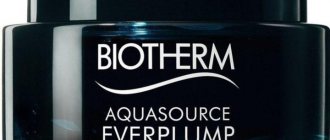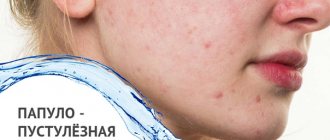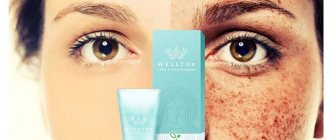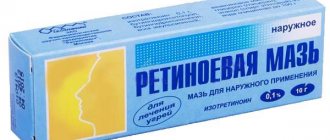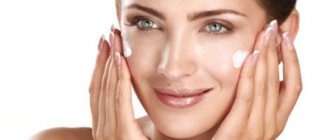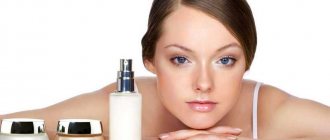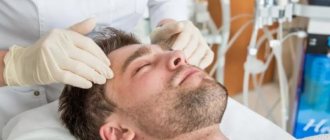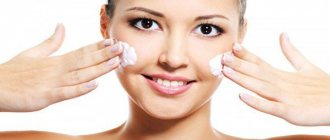What is a facial moisturizer with SPF protection? This is a daily skin care product with sun protection. Since such a balm will be used on an ongoing basis, its choice should be taken with full responsibility. Fortunately, the modern cosmetology market offers a wide selection for all needs and skin types.
But what does the abbreviation SPF mean? When deciphered and translated from English, you get something like a “sun protection factor”. This is an index that is used to indicate the degree of blocking of type B ultraviolet rays. The number next to these letters indicates how many percent of the rays are blocked. In simple terms, this is how strong the sun protection of a particular product is. Example:
- SPF-10 will protect against 90% of UVB rays;
- SPF-30 will not allow up to 95% of ultraviolet radiation to reach the skin;
- SPF-50+ is the highest level, capable of filtering up to 99%.
But UVB protection only provides protection from burns. Type A rays cause so-called photo-aging - drying of the skin, micro-wrinkles, age spots. Now there are products labeled UVA. They provide protection from both types of rays.
Skin phototypes
It is necessary for everyone to protect the epidermis from the sun, even small children, since ultraviolet rays can harm health and the dermis. In order to choose the right protection product, you need to correctly determine your skin phototype. The classification of people by phototype was proposed in 1975 by cosmetologist Dr. Richard Fitzpatrick.
There are 6 phototypes, each of which has its own distinctive features.
First phototype
It is called Celtic. People with this type of dermis have very fair skin, with a milky or porcelain tint, and blue or gray eyes. Girls of this type often have freckles and red hair. Most often such people are found in the European part of the earth. Girls with the Celtic skin phototype are hypersensitive to sunlight, so they rarely tan and often burn. Achieving an even tan is almost impossible. To do this, use a tanning cream.
Representatives of this type of dermis are more likely than others to develop skin cancer, so it is recommended to avoid direct exposure to sunlight and use ultraviolet protection. Protection factors should be chosen from 30 to 50 SPF. Girls should undergo chemical or laser peeling procedures with caution, as there is a high risk of developing hyperpigmentation.
Second phototype
It is called Nordic, Scandinavian or light European. Representatives of the Nordic phototype are distinguished by light skin, sometimes with freckles, and blue or gray-green eyes. The hair has a light brown or light brown tint. Girls with this skin type often get sunburned; an even tan is very rare.
It is recommended to stay in the sun for no more than 10-20 minutes, and use sun protection products of at least SPF 30. Sunbathing should be done at safe times, before 11 a.m. or after 4 p.m. If you plan to visit a solarium, the duration of the procedure should be no more than 15 minutes with breaks of two days.
Read about whitening creams for pigmentation here.
Third phototype
This is the Central European (dark) type. The dermis of such people has a slightly dark tint or ivory color, and there are no freckles. The hair is dark brown, brown, and the eyes are gray or brown.
Burns can occur with prolonged exposure to the sun. Most often, the tan goes on easily and has an even, dark shade. The degree of protection should be selected within the range of SPF 15-25. When tanning in a solarium, you should not choose exposures lasting more than 25 minutes. Breaks between procedures are 1-2 days.
Fourth phototype
Mediterranean or South European. Representatives of this skin type have dark or olive skin with no freckles. The hair is black or dark brown, and the eyes are most often brown or dark brown. Sunburn is rare because the dermis has a naturally high degree of protection.
For UV protection, it is recommended to choose products with SPF from 8 to 20.
Fifth type
This is Asian, Middle Eastern. The skin of such people is dark or has a yellow tint. No freckles. The hair is dark or black, the eyes are dark brown or even black. It is almost impossible for such people to get sunburned, since the dermis has its own high degree of protection from ultraviolet radiation.
You should use protective equipment during prolonged exposure to the sun, with an SPF of no more than 10. Girls should use chemical and laser peels with caution, as there is a risk of developing hyperpigmentation.
Sixth type
African American or Asian. The skin color of such people is dark brown, their hair is black, and their eyes are dark brown. The dermis of such people has a very high degree of photoprotection, which means that it is impossible to get burns. People can be in the sun without fear of sunburn.
There is no need to use protective equipment; it is enough to use moisturizing and nourishing creams to protect against photoaging of the skin.
Sunscreens should be chosen based on your skin phototype. This will preserve the youth of the dermis and prevent sunburn.
Find out how to choose sunscreen for problem skin by following the link.
If a girl has dyed blond hair or wears colored contact lenses, you should choose protective equipment based on the natural color of your hair and eyes.
The need for sunscreen for oily skin
Ultraviolet rays pose a huge danger to humans if protection from them is neglected and careless about the amount of time spent in the open sun. It doesn’t matter at all what type of dermis this or that person has - absolutely everyone has a need for protection.
In the event that you stubbornly avoid protection for absolutely untrue reasons that a bronze tint will appear on the skin much more likely if you do not use Sanskrins, many problems may arise, among which the most common are the following:
- getting a sunburn or peeling;
- increased wrinkles and other signs of aging;
- excessive dryness of the skin;
- the appearance of pigment spots.
It is also quite common for situations when, under the influence of sunlight, moles degenerate into malignant tumors and a person becomes ill with melanoma, a serious oncological disease that is almost untreatable.
Ultraviolet radiation is especially harmful to those with oily dermis, because it provokes:
- increased sebum secretion;
- hyperkeratosis due to the skin's need for protection;
- pore expansion;
- the occurrence of acne due to blockage of the ducts of the sebaceous glands.
The possibility of cosmetic defects such as acne is the only reason for skin protection for those people who absolutely do not care about their health for the sake of beauty.
We recommend reading the article about Nivea sunscreen. From it you will learn about the options for sunscreens from Nivea and their composition, when to use SPF 30 and when to use 50, as well as the cost of the products. Find out more about sunscreen for sensitive skin here.
What are SPF and PA+++
When buying cosmetics, you should pay attention to what protection level is indicated on the product. There are several levels of protection (SPF and PA).
SPF categories
SPF stands for Sun Protection Factor. In other words, this is a factor that shows the degree of reflection of the sun's rays of spectrum B. The SPF number indicates the duration of ultraviolet protection. Let's say a girl has the first skin phototype, which means she turns red after 5-10 minutes of exposure to the sun. By applying a sunscreen with the required degree of protection to the dermis, you can avoid burns and extend the time of sunbathing.
SPF protection level:
- SPF 2-4 is basic protection and protects from 50-75% of ultraviolet rays;
- SPF 4-10 has a medium level of protection, which protects against 85% of UV rays;
- SPF 10-20 has a high degree of protection from 95% of UV rays;
- SPF 20-30 is an intense degree of protection against 97% of harmful rays;
- SPF 50 protects against 99.5% of harmful rays - it's like a sun block.
Description PA
PA indicates the degree of protection from spectrum A rays. The degree of protection varies by the number of + signs. The more signs, the greater the level of protective properties.
- PA+ has a minimum degree of UV A protection;
- PA++ has average protection against UV A;
- PA +++ has very high protection against UV A radiation.
When using several creams with different SPF levels, you should focus on a higher indicator, since the indicators of the products do not add up.
The best premium sunscreens for the face
Premium segment products are of very high quality. Their compositions contain patented, specially developed components and complexes that effectively care for the skin and can have a therapeutic effect. Products in this category have been laboratory tested and are intended for people with very sensitive and even damaged skin.
4 Ducray Melascreen SPF 50
The rating of premium products opens with Melascreen SPF 50 cream from Ducray.
Ducray brand products are created in dermatological laboratories and belong to pharmaceutical cosmetics. The Melascreen line of products was created specifically to combat hyperpigmentation and eliminate age spots. The cream has a high protection factor and has a delicate texture. It spreads easily and is quickly absorbed without leaving any unpleasant sensations.
Sanskrin can protect even very fair skin and prevent redness and sunburn. The formula combines physical filters and organic screens, thereby preventing the penetration of UVA and UVB rays. Clinical trials have proven that the cream, with regular use, can lighten age spots by 97%.
The composition is enriched with vitamin E, widely known for its antioxidant properties. It suppresses the action of free radicals and protects against premature aging.
The formula is hypoallergenic, fragrance-free and suitable for sensitive skin.
Pros:
- High level of protection.
- Lightens age spots by 97%.
- Protects against premature aging.
- Suitable for very fair and sensitive skin.
- Hypoallergenic.
- Water resistant.
Minuses:
- Shines on the face.
Ducray cream Melascreen SPF 50
3 Avene with mineral screen SPF 50
Third place goes to AVENE cream with mineral screen SPF 50. The product was created specifically for those with particularly sensitive skin and for those who cannot tolerate chemical filters and fragrances.
The patented complex of mineral filters “SunSitive” protects against the entire spectrum of solar radiation. The titanium dioxide physical filter is available in nanoparticle format, which provides even greater protection than large particles.
The cream is suitable for children and adults suffering from atopic dermatitis or having damage to the skin, such as fresh scars. Sanskrin will not only reliably protect damaged tissues from exposure to sunlight, but will not cause irritation itself. The Avene thermal water included in the composition will moisturize and soothe the skin.
The formula is enriched with pretocopheryl, a precursor to vitamin E. It has an antioxidant effect and protects the epidermis from damage.
The product is waterproof and photostable.
Pros:
- Patented mineral screen.
- Suitable for very fair, sensitive and damaged skin.
- Hypoallergenic.
- Water resistant.
- 100% photostable.
- Suitable for children.
Minuses:
- Lays down in a white layer.
Avene SPF 50 reviews
Avene cream with mineral shield SPF 50
2 Bioderma Photoderm Max SPF 50
In second position is Photoderm MAX SPF 50 cream from the pharmaceutical cosmetics manufacturer Bioderma.
It is intended for very fair skin prone to burns, freckles and age spots. Protection is provided by the patented innovative Cellular Bioprotection complex, containing filters against spectrum A and B sun rays. It includes Ectoin and Mannitol. Ectoine is a natural molecule that can protect cells from UV radiation, burns, thermal shock and dehydration. Mannitol has a preventive and therapeutic effect on the epidermis when damaged by solar radiation.
The formula protects the structure of the epidermis at the cellular level, thereby preventing photoaging and the appearance of pigmentation.
The product is waterproof and does not require frequent updating; it is perfect for a beach holiday.
The manufacturer recommends using its product even in conditions of extreme solar radiation, such as in the mountains, tropics and open sun. It can also be used after cosmetic procedures, for example, peeling, laser.
Pros:
- Patented complex “Cellular bioprotection”.
- Suitable for very fair and sensitive skin.
- Prevents photoaging and the appearance of pigmentation.
- Hypoallergenic.
- Water resistant.
- Can be used in extreme conditions.
Minuses:
- Leaves an oily sheen on the skin.
Bioderma cream Photoderm Max SPF 50
1 La Roche-Posay Anthelios Ultra for face and eye area SPF 50
The leader among the premium segment products was Anthelios Ultra cream for the face and skin around the eyes SPF 50 from La Roche-Posay.
The product is available in a plastic tube with a convenient pump dispenser. The product has a dense, thick consistency, but upon contact with the skin it instantly melts and spreads easily, leaving no white marks.
The manufacturer tried to use a minimum number of components, but at the same time achieve high efficiency of the product. The formula does not contain parabens or synthetic fragrances.
High protection is provided by XL-Protect technology, which includes photostable filters. They protect the epidermis from exposure to a wide range of sunlight. Filter efficiency is enhanced by INTELIMER technology, which provides more uniform coverage. The healing thermal water included in the composition soothes and deeply moisturizes the skin. Selenium acts as an antioxidant. It neutralizes free radicals that are formed while under the sun.
The product is water and sweat resistant, so it does not require frequent renewal. Sunscreen is safe even for use on the sensitive area around the eyes, which is confirmed by tests under the supervision of dermatologists and ophthalmologists.
Pros:
- XL-Protect technology.
- INTELIMER technology.
- Suitable for sensitive skin around the eyes.
- Hypoallergenic.
- Water resistant.
- Photostable.
- Melting structure.
Minuses:
- Leaves a slight shine.
La Roche-Posay Anthelios Ultra face and eye cream SPF 50
Types of filters in creams
All sunscreen products contain physical and chemical filters, so you should pay attention to which product you purchase.
Physical
Physical filters are considered natural or mineral. They are not capable of causing severe harm to health. Such filters reflect ultraviolet rays from the dermis, thereby protecting it.
Find out what creams you can find at the pharmacy in this article.
You should not use a cream containing SPF sun protection at night.
Physical filters in cosmetics include:
- Titanium dioxide;
- Zinc oxide.
Chemical
Chemical filters are less safe for the body than physical ones. They absorb ultraviolet rays.
When the product is applied to the dermis, a thin protective film is formed, which absorbs harmful radiation.
Chemical filters include:
- Avobenzone;
- Benzophenone;
- Oxybenzene;
- Octinoxate and others.
The best protective properties are shown by creams containing both physical and chemical filters.
If you stay in the sun for a long time, you should renew the cream applied to the dermis every two hours, since under the influence of sunlight, chemical filters begin to oxidize, thereby forming free radicals. Free radicals can cause even more damage to the skin than the sun's rays.
You can find a list of creams with spf-50 at the provided link.
In order to reduce the chemical effects of SPF cream, it is recommended to first apply an antioxidant to the dermis, and only then a sunscreen product.
About the benefits of tanning
When exposed to sunlight, the skin begins to actively produce melanin, resulting in a tan. The greater the impact, the darker the skin becomes.
The following benefits from light and proper tanning can be highlighted:
- As you know, “sunbathing” activates the body’s production of vitamin D, which is an important element for the strength of the musculoskeletal system. Therefore, it is recommended to walk outdoors every day, even in bad weather.
- The sun's rays can treat various skin diseases, because they have a drying effect. For example, you can treat eczema, psoriasis, acne while on the beach during the permitted hours, namely in the morning and evening.
- The sun's rays have a positive effect on the functioning of important organs and systems, accelerate metabolic processes in the body, and affect mood and overall well-being. That is why, after a vacation at seaside resorts, a person feels a charge of vivacity and energy for the whole year.
- For older people, moderate “sunbathing” is especially useful, as it relieves pain in muscles and bones.
- Accelerating the proliferation of protective cells against viruses and bacteria is another benefit of tanning. This is why people get sick less in the summer than at other times of the year.
- Under the influence of sunlight, the body actively produces the “happiness hormone” endorphin, which has a positive effect on the nervous system.
- Prevention of rickets. Pediatricians recommend that young mothers take daily walks with their babies in any weather to ensure proper growth and development of the musculoskeletal system.
The most important thing is to sunbathe wisely, only during safe hours, using proven and reliable protective creams to avoid burns and other skin diseases.
Compositions
When choosing a dermal care product, you should pay attention to the composition of the product. As mentioned earlier, all protective equipment has chemical and physical filters.
The most common and safest are physical filters such as zinc oxide, titanium dioxide, etc. These components are not able to penetrate deep into the epidermis and accumulate there. The effect of the cream begins immediately after applying the product to the dermis.
The presence of zinc oxide in the composition helps prevent the formation of free radicals and protects the epidermis from harmful ultraviolet rays.
Titanium dioxide is a mineral component that has strong protective properties for the dermis. Mineral components are reflectors of sunlight.
Persons with sensitive skin are recommended to use cosmetics that contain lecithin and salicylic acid. These components perfectly protect the skin, nourish it and moisturize it. Once on the epidermis, lecithin begins to protect the dermis from harmful effects on the skin, and salicylic acid fights inflammation and redness of the epidermis.
In addition to physical and chemical filters, various oils are added to the sunscreen, such as avocado, coconut oil, etc., as well as vitamins A, E, minerals and antioxidants.
Choosing a sunscreen based on radiation type
All packages of Sanskrins indicate the type of rays from which they protect - UVA and UVB. Both types of radiation cause skin cancer, the difference between them is in the wavelength and specific effects:
- UVA rays have the longest wavelength and lowest energy. They easily penetrate through light clothing, glass and clouds. This radiation makes up 95% of all UV radiation that reaches the earth, so a person is always exposed to it when he is outdoors during daylight hours. UVA penetrates deep into the skin and causes wrinkles.
- UVB rays are not able to penetrate fabrics, glass and clouds. Some of this radiation is absorbed by the ozone layer, and approximately 5% of the total UVB rays reach us between 11:00 and 16:00. These rays are not as intense as UVA, but even small amounts cause skin redness and sunburn.
The amount of sunblock you apply matters. So, you need to apply 1 ml of cream to your face - an amount slightly larger than a 10-kopeck coin. Don't forget about your neck and exposed areas of the body, using protective products with a factor of at least 30. When outside, remember that you need to renew your protection every 2 hours. For example, sprays with SPF are suitable for this.
Laneige Volume Sun Body Spray SPF 50 PA+++ is convenient to take with you if you expect to be outside all day. A few sprays will protect the skin from damage
What harm can it cause
The safest and most harmless filters for the human body are physical filters that reflect B ray radiation. The main negative point when using cosmetics with physical filters is clogging of pores and the possibility of developing inflammation. Most of all, such symptoms appear in people suffering from inflammation and acne formation.
Chemical filters are capable of adsorbing ultraviolet radiation. The danger of using chemical filters lies in their ability to penetrate deep into the epidermis and accumulate in the skin, having a toxic effect on the body as a whole. This manifests itself primarily in severe allergic reactions, hormonal imbalances, etc., so pregnant and lactating women should not use cosmetics with chemical filters.
Chemical components can harm reproductive function in men, so it is not recommended to use such cosmetics frequently.
Choosing sunscreen by price
The protective properties of sun cream do not depend on its price. Budget, luxury, and professional brands have sunscreen products. A Sanblock for $100 does not protect more reliably than one for $10. The difference is in the textures, additional caring components, packaging and brand strength, of course.
It is better to choose a sunscreen for the body based on your skin type, and not its price. For oily skin, oil-based products are suitable. If your skin is sensitive and prone to breakouts, you can choose a sunscreen with soothing ingredients such as aloe vera or centella asiatica. Cosmetics for sensitive skin should be simple and contain a minimum of ingredients. The texture of any product should be creamy or oily, without alcohol.
Badger SPF 30 Unscented Sunscreen Cream based on zinc oxide (physical filter) contains only 5 components. Simple, safe and affordable
Types of creams
When choosing a cosmetic product, you should pay attention not only to the degree of protection, but also to its other functions. Sunscreens come in various types and properties.
Multifunctional
Multifunctional cream performs several functions for the skin at once. Thanks to its rich composition, it is able to moisturize the epidermis, saturate and nourish it with essential substances, and also protect the dermis from premature aging.
The product contains vitamin E to moisturize the skin, oils to nourish the epidermis, and hyaluronic acid for rejuvenation. Protection level SPF 50 with P++++ filter, that is, it provides maximum protection against ultraviolet radiation. A good example is L'Oreal.
MULTI-FUNCTIONAL SUN PROTECTION CREAM FOOD A HOLIC MULTI SUN CREAM SPF50+ PA+++has an average cost in Russia of 450-500 rubles.
Protective
The main purpose of sunscreens is to ensure safe sun exposure. Such products contain components that do not allow harmful ultraviolet rays to penetrate deep into the epidermis.
Read this material on how to use Floralis cream with SPF-50.
Nutritious
Nourishing facial care products are most often used at night, as they contain vitamins and oils that are so necessary to preserve the youth and beauty of the epidermis. It also contains various plant extracts, such as echinacea.
At night, the facial muscles relax, which means that nutrients can penetrate deeper into the epidermis. The nourishing creams contain panthenol, which promotes skin regeneration. The average protection level of these creams is SPF 30. Such products are available in the Faberlic line.
The average cost of nourishing sunscreen Cora is 400-450 rubles.
Moisturizing
Many people believe that only dry skin needs additional hydration. In fact, this is not the case, and with age, any type of dermis needs additional moisture. Using a moisturizer helps retain the necessary moisture in the skin and protect the dermis from drying out in the sun.
Moisturizing creams contain various extracts, oils and vitamins. It is also recommended to use products containing hyaluronic acid and elastin if you are over 30. A good example is Librederm Bronzeada face and décolleté cream SPF 30.
Moisturizing sunscreen Mild Sun Block SPF 45 costs 600-700 rubles.
Day
Face care creams are divided into day and night. They differ not only in composition, but also in consistency. The daytime product is designed to provide optimal levels of hydration throughout the day. The protection of day creams depends on your skin type.
It is advisable to use at least SPF 15 for daytime protection. Such products require the presence of glycerin, which maintains the lipid balance of the dermis, Shea butter, for moisturizing and nourishing. Avon multi-protective day cream is popular.
Sunscreen from Arkady costs 950 rubles in Russia.
Anti-aging
Fading and aging skin needs additional protection. You should choose care products with SPF from 30 to 50. The product should contain hyaluronic acid, peptides, collagen and elastin, coenzymes, etc. These components are mandatory components of all anti-aging cosmetics. They protect the skin from premature aging and promote dermal regeneration. Lecithin can relieve inflammation and redness, so its presence in the composition is also a good sign. Cream with peptides SPF-50 Lora meets all these criteria.
The cost of sunscreen from Garnier is 400-500 rubles.
Under makeup
When choosing sunscreen for makeup, you should give preference to those products that have a protection level of at least SPF 30.
You can choose a sunscreen BB cream, this way you can solve problems in applying foundation. BB cream is selected to match the skin color and has the necessary degree of protection.
Sunscreen BB cream from Garnier costs 600 rubles.
What sunscreen ingredients should you pay attention to?
In addition to the most important English letters: SPF and PPD, such important markers of the reliability of a protective cream, the ingredients of such creams are important so that they can best suit our individual needs.
The main task of a protective cream, with all its ingredients, is to create a screening effect when applied to the skin in a thin layer, capable of reflecting both types of ultraviolet radiation. Unfortunately, manufacturers of such creams choose the easier way: they create mainly creams of the SPF type, which can cope with thermal sunburn, but are helpless against type B rays, which bring a greater, but not immediately obvious effect, leading to cancerous growths on the skin. Therefore, when choosing a safe tanning cream, you need to look in the list of its components for parsol or avobenzone, which has a tinting effect.
People susceptible to allergic reactions or prone to increased uneven pigmentation should take into account special requirements for protective creams. For them, the presence of PPD is an indispensable condition, and SPF protection must be at least level 30, although this figure depends on the location of sun exposure and its duration. For holidays in the country, a cream with points from 3 to 30 is suitable, and staying in hot resort areas requires a high degree of protection: 20-30.
Those who carefully monitor the youth of their skin and do not want to acquire “sailor skin”, tanned and furrowed with wrinkles, will find the advice of the chief dermatologist of the Russian Federation Anna Alekseevna Kubanova useful - first of all, remember about photoaging of the skin, manifested by early wrinkles, dehydration of the skin, in which thinning and aging. In this case, the protective cream should include nutrients and moisturizers, which will help the skin remain healthy and youthful. For example, plant extracts and essential oils of chamomile and green tea, which relieve irritation and moisturize the skin, will do an excellent job of this task.
For your information! Skin is the largest human organ. In its healthy state, it can secrete 30 grams of salt, 50 grams of lard and 1 liter of water per day.
Knowing the individual properties of your skin and its chemical composition greatly simplifies the problem of choosing the optimal sunscreen for you. In the absence of such data, it is necessary to conduct a preliminary personal test of the purchased cream by applying it to the inside of the elbow for 10-15 minutes. The absence of irritation on the control area of the skin will give approval for the use of the test cream.
You can get more detailed answers on the question of choosing the right protective cream in consultation with specialists: a cosmetologist or a dermatologist. In addition, sunscreen must be stored and used according to the instructions: at the specified temperature, strictly observing its expiration date. Don’t forget about protecting your skin from the inside - try to drink the required amount of water, eat right and provide your body with natural antioxidants, and also add healthy foods with omega-3 acids to your diet. So, I wish you good health, beautiful skin, an even tan and a great mood.
How to use: practical recommendations
In addition to sunscreen, you should not forget to use skincare products that suit your dermis type.
Rules for applying the cream:
- sun protection products are applied to the face 20-30 minutes before going out so that the product has time to be absorbed;
- if you use a skin care cream, for example a moisturizer, then apply it first, and then apply a sunscreen with SPF on it;
- creams are applied in an even, thick layer so that the protective properties are not reduced;
- when bathing, you should choose a cream with waterproof properties;
- A product containing chemical filters should be renewed at least once every two hours.
how to choose SPF depending on skin type
- SPF 30-50 . Suitable for very fair skin that burns easily. This cream can be applied to skin that is already slightly tanned or to non-tanned skin.
- SPF 15-30 . Suitable for fair skin that sometimes burns, but the tan always applies well.
- SPF 6-15 . Suitable for those with medium skin tone (neither light nor very dark). This type of skin usually burns minimally in the sun and the tan always applies well.
- SPF 2-10 . Suitable for dark and dark skin, which very rarely (rather never) gets sunburned.
How to choose
You should choose cosmetics according to the type of your dermis. It is necessary to pay attention to the composition of the product. Preference should be given to those creams that contain caring components and a minimum of chemical filters. It is best if the composition contains physical filters, as they are less harmful to the epidermis.
For maximum protection from the harmful effects of ultraviolet radiation, you should choose a product with a thick consistency. Also, do not forget to pay attention to the expiration date of the product.
The caring cream should contain panthenol and soothing extracts. Cosmetics should be chosen from well-known manufacturers, as they undergo strict control and comply with all safety rules.
Find the best sunscreens here.
Don't forget that the older you are, the higher the level of SPF protection.
How do different SPFs affect your tan?
Almost every sunscreen line has products with different SPF levels. Each has its own special effect and promotes tanning.
Some believe that if you want to get a quick and beautiful color, you need to use creams with low protection, and a high factor does not allow the skin to acquire a shade. But it is not so. You can tan through sunscreen with any level of filter, the question is quality.
A low SPF factor of 10-25+ only stimulates rapid and greater melanin production. You can tan with this sunscreen, but it has significant drawbacks. The main disadvantage is that the pigment may not apply evenly.
Melanocytes are distributed spontaneously and in varying numbers throughout the skin. In addition, only the top layers are affected. Therefore, such a quick tan will soon be washed off, especially if you use scrubs and a hard washcloth.
Also, the quality of the skin deteriorates, it becomes reddish, dry and dull. The fact is that when the dermis is exposed to ultraviolet radiation, it produces red pigment - melanin, but black and yellow, which give a lasting and golden tan, appear much later. They protect the skin from the harmful effects of ultraviolet rays, but red does not do this. As a result, scarlet melanin gives an unsightly and uneven tone, quickly disappears, leaving spots.
But creams with a high level of SPF-30-50+ not only provide skin protection from the negative effects of the sun, but also provide a more lasting and even tan. And although a person darkens more slowly, redness and burns do not appear, and the tone is even and lasting. This tan can last for several months. The skin is not stressed. Products with SPF 50+ additionally block free radicals.
Expert opinion
Irina Kovaleva
Cosmetology expert
In any case, experts from the International Skin Cancer Foundation insist that the product must have an SPF protection factor of at least 15, otherwise it does not work and does not help the epidermis.

